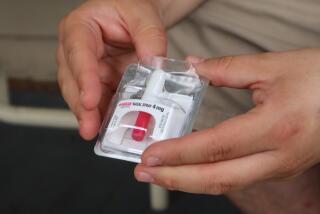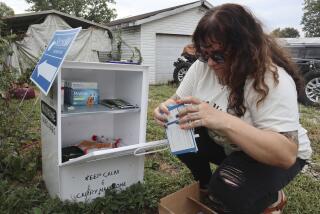A swift lifesaver in heroin overdoses
The young New York woman had just gotten home from rehab but couldn’t wait to shoot up again. Her parents, who lived in an affluent neighborhood of Long Island’s Suffolk County, found her in the shower when they heard the water running too long.
She had overdosed on heroin.
By the time Suffolk County Police Officer James Garside and a firefighter arrived and pulled her out of the bathroom, she wasn’t breathing.
That’s when they gave her a dose of naloxone, the go-to drug for treating heroin and painkiller overdoses.
About a minute later, her eyes started to flutter. She started to breathe on her own. Within three minutes, she sat straight up. “And all that was performed in front of her parents,” recalled Garside, who is also a trained paramedic.
Rescue stories like this one from early 2013 are becoming more common as heroin makes a comeback in the United States, hitting the Northeast particularly hard as painkiller abusers switch to the cheaper illicit drug. Heroin use gained even more attention this week after Oscar-winning actor Philip Seymour Hoffman was found dead of a possible overdose in his New York apartment.
Some federal data suggest that heroin use has roughly doubled across the country, bringing a corresponding rise in pricey emergency responses and fatal overdoses.
Naloxone could play a big role in trying to fight off that increase in deaths, but it is not widely available to many users and emergency responders, despite a success rate that normally exceeds 80% or 90%, experts say.
“No one really thought to have any particular policies in place expanding access to naloxone. No one was having those conversations,” said Meghan Ralston, the harm reduction manager for Drug Policy Alliance, an advocacy group. She called naloxone “an obscure little wonder drug that has been used with quiet success for decades.”
“It’s incredibly safe and effective, and lawmakers don’t really know anything about it, except they’re hearing from physicians and others that we need to do more to get these drugs in the hands of moms and others” who know heroin and painkiller abusers, Ralston said.
Legislatures in blue and red states alike are considering proposals that would expand access to naloxone, with bills introduced by Democrats and Republicans.
A California law took effect Jan. 1 allowing family and friends of heroin and painkiller users to obtain the antidote from doctors. The idea is to have the drug at the ready in case a loved one overdoses.
The Network for Public Health Law says California is one of 17 states, plus the District of Columbia, that have adopted laws expanding access to naloxone, which is commonly branded as Narcan.
Nine of those states adopted their laws within the last year. California Assemblyman Richard Hershel Bloom (D-Santa Monica) introduced legislation last week that would make naloxone available over the counter.
“I think of Narcan access as a really low-hanging fruit,” Corey Davis, deputy director at the Network for Public Health Law, said in a telephone interview from Chapel Hill, N.C. “There are a lot of things that states can and should be doing to reduce overdose deaths, but increasing access to Narcan is so obvious and easy.”
New York limits naloxone access to certain first responders. But a pilot program to give a nasal-spritzer form of the drug to police in Suffolk County has met resounding success over the last 18 months. Suffolk police say naloxone has reversed 172 of the 178 overdoses in which officers administered the drug.
“They literally are at death’s door with respirations of maybe two a minute, and when you administer the medication, it’s a dramatic reversal within three or four minutes,” said Dr. Scott Coyne, the police department’s chief surgeon and medical director.
Fourteen states and the District of Columbia also have passed so-called good Samaritan laws that would offer some immunity to drug users who call 911 during an overdose, according to the Network for Public Health Law. California is one of them.
Just three days before Hoffman’s death, New York state Sen. Kemp Hannon introduced legislation that would distribute naloxone through public training programs, issuing the drug on completion of the training.
Heather Edney, 43, of Los Angeles can’t remember how many times she has been revived with naloxone, perhaps five. But the last time she was saved by the drug, 10 years ago, was also the last time she ever used heroin.
Naloxone “absolutely” saved her life, she said. The people she was with were not going to call 911 “because they could have legal ramifications,” she said.
“I got a second chance at life,” said Edney, now a behavioral healthcare consultant who helps organize drug treatment programs. “I’ve been living an amazing life for 10 years. I’ve been helping other people get treatment -- none of that happens without naloxone.”
Naloxone, which has few if any side effects, counteracts the effects of opioids such as OxyContin and heroin by blocking the receptors in the brain that take in the drugs.
When injected into an overdose victim whose heart is still beating, “it’s virtually 100% effective,” said Wilson Compton, deputy director at the National Institute on Drug Abuse in Bethesda, Md.
Edney dismissed the possibility that providing naloxone to addicts would only enable them to overdose again. “When you’re using, you’re using,” she said. “For me, I used to use it [heroin] because I wasn’t even thinking about it, let alone naloxone.”
Getting a dose of naloxone isn’t pleasant, she said: It’s like waking up, except with sudden opium withdrawal symptoms, depending on how quickly a user is brought out of an overdose.
“There’s nothing about it that’s good,” Edney said, “because you go from being blissfully unaware to being, ‘Now I’m conscious. I’m in withdrawal, and everyone’s staring at me.’”
--
More to Read
Sign up for Essential California
The most important California stories and recommendations in your inbox every morning.
You may occasionally receive promotional content from the Los Angeles Times.











